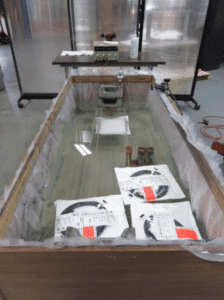ASTM F2096
Standard Test Method for Detecting Gross Leaks in Packaging by Internal Pressurization (Bubble Test)
Micom offers ASTM F2096 testing as part of its package testing and of its medical package testing services. ASTM F2096—Detecting gross leaks in packaging by internal pressurization (bubble test)—describes a procedure to detect gross leaks from porous and non-permeable packaging materials through the use of a bubble test. Moreover, this method may be used as a means to assess the integrity of sterile package materials. As a matter of fact, the latter could be associated with an accelerated aging test such as ASTM F1980 in order to characterize this attribute.
Identification of gross leak from porous and non-porous materials—use and factors to consider:
 The goal of ASTM F2096 is to detect gross discharges from permeable and non-porous packaging materials through the use of a bubble test. The latter consists of identifying a steady bubble stream present at an area of failure after the sample had been inflated to a predetermined pressure under water. This standard details two methods and their use is limited to a particular kind of material. Indeed, method A is used for non-permeable compounds while method B is employed for pervious materials. The difference between those two is the fact that there is a water saturation period for the porous materials. Lastly, this standard may be used as a means to evaluate the integrity of packages that are designed to provide an uncontaminated environment.
The goal of ASTM F2096 is to detect gross discharges from permeable and non-porous packaging materials through the use of a bubble test. The latter consists of identifying a steady bubble stream present at an area of failure after the sample had been inflated to a predetermined pressure under water. This standard details two methods and their use is limited to a particular kind of material. Indeed, method A is used for non-permeable compounds while method B is employed for pervious materials. The difference between those two is the fact that there is a water saturation period for the porous materials. Lastly, this standard may be used as a means to evaluate the integrity of packages that are designed to provide an uncontaminated environment.
The main factors that are to be considered when running this test are: the method of pressurization and the determination of the test pressure.
Typical Experimental parameters for ASTM F2096 testing:
The number of samples required has to be specified. Also, a control specimen has to be used in order to establish the test pressure.
Other test methods related to ASTM F2096:
For additional related test methods, please see accelerated aging test.

